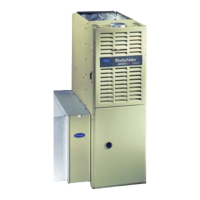d. Find installation altitude in Table 11.
NOTE: For Canada altitudes of 2000 to 4500 ft, use U.S.A.
altitudes of 2001 to 3000 ft in Table 11.
e. Find closest natural gas heat value and specific gravity in
Table 11.
f. Follow heat value and specific gravity lines to point of
intersection to find orifice size and low- and high-heat
manifold pressure settings for proper operation.
EXAMPLE: (0—2000 ft altitude)
Heating value = 1075 Btu/cu ft
Specific gravity = 0.62
Therefore: Orifice No. 45
Manifold pressure: 3.4-in. wc for high heat
1.4-in. wc for low heat
* Furnace is shipped with No. 45 orifices.
In this example, all main burner orifices are the correct size
and do not need to be changed to obtain proper input rate.
g. Check and verify burner orifice size in furnace. NEVER
ASSUME ORIFICE SIZE; ALWAYS CHECK AND
VERIFY.
3. Adjust manifold pressure to obtain input rate.
a. Remove caps that conceal adjustment screws for low- and
high-heat gas valve regulators. (See Fig. 18.)
b. Move setup switch SW-2 on control to ON position. (See
Fig. 15.) This keeps furnace locked in low-heat operation.
c. Jumper R and W/W1 thermostat connections on control to
start furnace.
d. Turn low-heat adjusting screw (5/64 hex Allen wrench)
counterclockwise (out) to decrease input rate or clockwise
(in) to increase input rate.
NOTE: DO NOT set low-heat manifold pressure less than 1.3-in.
wc or more than 1.7-in. wc for natural gas. If manifold pressure is
outside this range, change main burner orifices.
DO NOT bottom out gas valve regulator adjusting screw.
This can result in unregulated manifold pressure and result in
excess overfire and heat exchanger failures.
NOTE: If orifice hole appears damaged or it is suspected to have
been redrilled, check orifice hole with a numbered drill bit of
Table 10—Heat Pump Comfort Heating Nominal CFM at up to 0.70-in. w.c. ESP (With Filter)
AC/HP JUMPER POSITION: HP—CMFT HEAT PUMP—COMFORT, HEATING AIRFLOW
Furnace
Size
Airflow
Selection
Single-Speed
CFM
Two-Speed (High/Low)
CFM
Cool Size
Jumper
Position
Tons
Cool CFM Per Ton
Jumper Position
Cool CFM Per Ton Jumper Position
400 350 315
400 350 315 HIGH LOW HIGH LOW HIGH LOW
060
LO 1-1/2 540 500* 500* 565 500* 500* 500* 500* 500*
M-LO 2 720 630 570 780 500* 660 500* 595 500*
M-HI 2-1/2 900 790 710 945 585 830 515 740 500*
HI 3 1080 945 855 1135 700 990 610 895 555
080
LO 2-1/2 900 785 710 945 605 825 535 755 500*
M-LO 3 1080 945 850 1135 715 990 630 895 560
M-HI 3-1/2 1260 1100 990 1325 830 1150 725 1040 655
HI 4 1440 1260 1135 1510 940 1325 825 1190 740
100**
LO 3 1075 940 855 1130 700 980 700 890 700*
M-LO 3-1/2 1260 1100 990 1325 820 1155 750 1040 700*
M-HI 4 1440 1260 1130 1510 935 1320 825 1190 740
HI 5 1800 1575 1420 1890 1170 1655 1035 1490 920
120**
LO 3 1045 945 860 1075 780 975 750 885 750
M-LO 3-1/2 1260 1100 980 1280 875 1140 790 1035 760
M-HI 4 1440 1255 1125 1485 965 1320 880 1185 835
HI 5 1800 1575 1410 1900 1170 1650 1025 1475 970
* Minimum airflow is set for electronic air cleaner: 060—500 CFM, 080—500 CFM, 100—700 CFM, 120—700 CFM
→ ** Air delivery may be reduced by as much as 3% when using a single side return.
NOTE: Continuous-fan settings are 50%, 65%, or 100% of selected cooling airflow.
DO NOT redrill orifices. Improper drilling (burrs, out-of-
round holes, etc.) can cause excessive burner noise and
misdirection of burner flames. This can result in flame
impingement of burners and heat exchangers, causing
failures.
A93059
BURNER
ORIFICE
19

